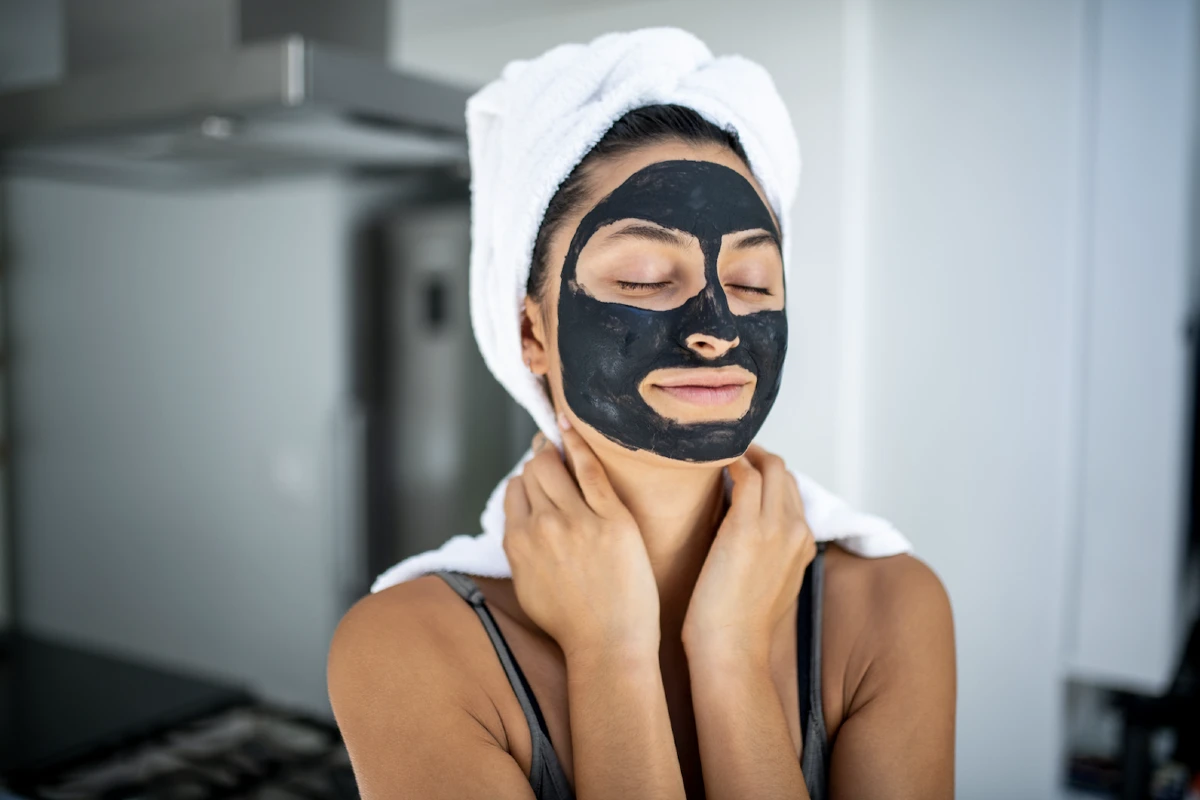
Every skin is beautiful — poreless or not — but if the look of enlarged pores is still bugging you, we’ve prepared some research-backed and expert-approved treatments that should get you rid of large pores once and forever.
Indeed, a complexion that looks as smooth and poreless as a baby’s face is one of the most sought-after traits for most of us. Yet, a lot of foes (think sun damage, the years you fought with puberty and cystic acne, sebum, and even aging) can drastically change the size of pores and leave them appearing more prominent.
Though large pores are harmless and aren’t actually a medical concern, they can still host all sorts of skin issues, including blackheads, dullness, and uneven texture. So it’s best to address them ASAP with a proper skincare routine that targets the specific cause of your large pores. P.S: While you can’t literally close your pores nor reduce their natural size, you can do plenty of things to make them appear smaller, so stay put.
What are pores?
Pores are small openings in the skin that secrete oil and release sweat from your glands. Briefly, their role is to regulate body temperature and allow sebum to travel through the skin’s surface to maintain it moisturized and protected against environmental stressors.
Large pores vs. open pores
Large pores or visible pores are often referred to as “open pores,” but that’s just wrong. Contrary to popular belief, you cannot open or close your pores, but pores can dilate and stretch.
What causes large pores?
Large pores can be a result of genetics, hormonal changes, sun damage, aging, sebum production, bacteria, and dead cell buildup.[1] Of all, studies confirmed that excess sebum and lack of skin elasticity (due to aging) have the heaviest impact on pore size.[2] So this goes without saying: if you have large pores, the first (and most important) step is to identify the exact causes so you can undergo the right treatment.
One of the most common causes of large pores is excess sebum production — which is why people with oily skin are more likely to have large pores.[2] Pores secret sebum, and when the body produces too much of it, the excess can dilate the pore diameter and make them appear visibly larger. Also, a buildup of dead cells and dirt trapped in your skin can push pores to grow in size. The moral of the story? Keep your pores clear to prevent clogging.
Sun damage and aging are also to blame for your large pores. Both deplete collagen levels in your body and make the skin around pores less elastic and firm, stretching the pores.[3] The fix? Use products that aim to restore collagen and maintain skin elasticity.
How to minimize large pores look
Regardless of what’s causing your large pores, here’s how to shrink their look step by step so you can finally enjoy smooth skin and even texture.
Avoid comedogenic products
Comedogenic products are those that contain pore-clogging ingredients, such as coconut oil and algae extract. Because they tend to block the pores, you want to avoid them at all costs. Here’s a list of comedogenic ingredients often found in skincare products you should steer clear of.
Cleanse your skin twice daily
Pores accumulate sebum, dirt, bacteria, and dead cells, which can eventually clog them and dilate their size. To avoid this and prevent buildup on the skin’s surface, cleanse your face two times a day (in your morning and nighttime routine) with a gentle face wash. For large pores, a charcoal cleanser does best. This is because charcoal works to remove impurities while decongesting pores, detoxifying skin, balancing sebum, and eliminating bacteria.
Use a toner with salicylic acid
Even though using a toner is optional, it can help remove the leftovers the cleanser did not wash off while adding extra benefits to your skin. A toner with salicylic acid is the best pick for enlarged pores. Salicylic acid is an exfoliant within the class of beta-hydroxy acids that’s oil-soluble, meaning it can penetrate the fat layers to reach the pores and clear them of dead cells, bacteria, and sebum. So using it in a toner is one of the “day-by-day” things you can do to minimize your large pores.
P.S: If you’re not into toners, you may want to use a salicylic acid cleanser to compensate — thanks us later.
Moisturize morning and night
You’ll have nothing to gain from a dehydrated complexion. When skin lacks moisture, it starts to produce more sebum to replenish the loss, which may cause an excess that can block the pores. So to get rid of large pores, it’s imperative to keep your skin moisturized. To do that, use a lightweight moisturizer filled with hydrating and moisture-retaining ingredients like hyaluronic acid, glycerin, squalane, and Centella asiatica twice daily. FYI, squalane mimics the skin’s natural sebum, so it can also help control and regulate sebum production, aside from moisturizing the skin.
Use a pore-minimizing serum
Having a pore-minimizing serum in your skincare routine is non-negotiable if you want to shrink large pores. Usually, these contain pore-clearing and sebum-controlling ingredients like exfoliants (glycolic, lactic, and salicylic acids), niacinamide, willow bark extract, and vitamin C. Vitamin C, niacinamide, as well as glycolic and lactic acids, have been specifically found effective to mitigate the impact of environmental factors on skin pores, consequently helping to tighten them.[3]
Use retinol at night
Retinol can help with a variety of skin woes, including reducing the appearance of large pores associated with aging. The theory is that retinol stimulates cell turnover, which reduces the chances of pore clogging. Besides, retinol boosts collagen production, helping tighten the skin around pores for a smoother appearance. In a 2015 clinical study, the use of a 0.5% retinol product every night for three months considerably mitigated the impact of photoaging on skin pores.[4]
While you nailed it with your pore-minimizing serum in the morning, in your PM routine, apply a retinol serum to allow it to work the night shift (while your skin is in repairing mode) to stimulate cell renewal and enhance firmness. Doing so, you will wake up to a smoother, tighter complexion and less visible pores over time.
If retinol doesn’t deliver to your expectations, you’ll have much better chances with prescription-strength retinoids. Tretinoin, isotretinoin, and tazarotene, all types of retinoids, have been found to have higher efficacy in improving facial pores, wrinkles, hyperpigmentation, and sebum production compared to OTC forms.[5]
Exfoliate
Regularly exfoliating your skin is a must to get rid of large pores. This is because exfoliation helps slough off the buildup of dead cells, oil, and debris trapped inside pores, keeping them clear. While there are more exfoliation methods, including chemical, enzymatic, and physical, the chemical one works best for large pores since it removes all pore-clogging elements not only from the surface but also beneath the skin’s first layer. Chemical exfoliants include alpha-hydroxy acids (AHAs) like lactic and glycolic acids and beta-hydroxy acids (BHAs) such as salicylic acid.
Ideally, use an exfoliant that contains both AHAs and BHAs. The reason is that AHAs are water-soluble, so they work more on the surface to remove the top layer of dead skin, while BHAs are lipid-soluble, so they can pass through the fat layers to reach the pores and dislodge the bacteria and gunk that blocks them.[6] More than that, in addition to unclogging pores, AHAs also boost collagen production — which may further minimize large pores by tightening the skin — and BHAs regulate sebum production and hinder bacteria growth.
For the best results, exfoliate your skin two or three times a week with a product containing a meaningful concentration of AHAs and BHAs. Studies found that BHAs provide the best results in a concentration of 1-2% while AHAs between 10 to 15%.[6] Make sure you follow up with a repairing moisturizer after exfoliation to accelerate the skin recovery process and mitigate possible irritation. P.S: We recommend these face exfoliators for clogged pores and congested skin.
Chemical peels
If you’re willing to achieve more dramatic results, you can try a chemical peel, which is basically exfoliation but with a much higher concentration of acids. Chemical peels usually use concentrations of up to 30% BHAs and 50% AHAs, respectively, and are performed in-office by a professional.
Steam facial
Does steaming your face help shrink pores? We’re glad you asked. A 10-minute steaming session is great for widening the pores and helping to unclog them. It’s best to do it before cleansing because the junk trapped inside the pores will shed off more quickly after the steam bath has opened the pores. All you have to do is heat up the water to boil it, pour it into the bowl, drape a towel over your head, and lower your head toward the bowl, keeping a 10-14 inches distance. In 4-5 minutes, your pores will open, then you can move to the next step, aka cleansing your complexion. Or, if you don’t want to bother with all the effort, go for a monthly facial, where you get steaming, extraction, and hydration for less noticeable pores.
Never skip sunscreen
Sun damage is known to degrade collagen levels in the skin, consequently leading to so-called photoaging, which results in a loss of elasticity and firmness.[2] In turn, this causes the perimeter of pores to become looser and larger, which makes them appear more prominent. For this reason, you should protect your skin against sun damage all year long by diligently using SPF 50 sunscreen as the last step of your morning skincare routine. Even better if you use a vitamin C sunscreen, which, aside from fighting free radicals and reducing environmental damage, also hikes up collagen production to stretch and tighten the skin around pores.
Face mask with charcoal and clay
Applying a face mask with charcoal and clays can also improve the look of large pores. Both charcoal and clay act as a magnet to draw impurities from the pores, being super effective for detoxifying and decongesting the skin. You can find a mask infused with these two skin decongestants here — use it once or twice weekly to purify your pores and keep them clear of gunk.
Microneedling
Microneedling is a versatile solution for diminishing the appearance of large pores, scars, and stretch marks. The treatment involves pricking the skin with tiny sterilized needles to cause controlled damage, which encourages more collagen production. By increasing collagen and elastin production, microneedling can drastically improve the skin’s texture and laxity in the long run.[7] While this procedure is usually performed in professional salons, you can also do it at home by using a microneedling pen specifically designed for home use. Warning: at-home dermarolling should never be done with needles exceeding 0.5 mm — the risk of infection and tissue damage is too high.
Laser resurfacing
Laser resurfacing is one of the most effective solutions for large pores and, when performed regularly, can make a much more noticeable difference than most at-home treatments. Briefly, the procedure works by using a controlled laser to remove the outer skin layer while heating the dermis (beneath the skin surface). The results range from increasing cell turnover and improving collagen production to thickening and retexturizing the skin, all of which lead to a smoother, poreless complexion. You typically need a couple of sessions to get visible results, with appointments scheduled once every four to eight weeks.
Skincare routine for large pores
AM
- Cleanse your face with a non-stripping and hydrating face wash for about one minute and rinse thoroughly.
- Apply toner with salicylic acid evenly to the entire face with a gauze pad, avoiding the eye area. Do not rinse off.
- Use a pore-minimizing serum containing niacinamide, exfoliants, willow bark extract, or vitamin C.
- Moisturize with a lightweight and non-comedogenic formula.
- Apply sunscreen.
PM
- Cleanse.
- Optionally (but preferably), use the toner.
- Apply a retinol serum.
- Moisturize.
Weekly
- Exfoliate two or three times weekly with a product containing salicylic acid and glycolic acid.
- Once or two times a week, use a face mask with charcoal and clay to soak up the excess sebum and impurities.
- Steam facial
To end
Before you go, there’s one more thing you must ensure you do every day: never pick at your pores or squeeze the skin. Both can irritate your skin and makes pores look more noticeable, so it’s a big no-no.
Sources
Women’s Concepts uses reliable sources, including dermatologists’ insights, clinical trials, and scientific journals, to find accurate information and support all the facts shared in our articles. All statements and claims have clear and legit references. Read our editorial policy to learn more about our sources of information, our process of researching and fact-checking the content, and how our team strives to keep all articles updated, completed, and trustworthy.
- Lee SJ, Seok J, Jeong SY, Park KY, Li K, Seo SJ. Facial Pores: Definition, Causes, and Treatment Options. Dermatol Surg. 2016 Mar.
- Kim BY, Choi JW, Park KC, Youn SW. Sebum, acne, skin elasticity, and gender difference – which is the major influencing factor for facial pores? Skin Res Technol. 2013 Feb.
- Flament F, Francois G, Qiu H, Ye C, Hanaya T, Batisse D, Cointereau-Chardon S, Seixas MD, Dal Belo SE, Bazin R. Facial skin pores: a multiethnic study. Clin Cosmet Investig Dermatol. 2015 Feb 16.
- Bouloc A, Vergnanini AL, Issa MC. A double-blind randomized study comparing the association of Retinol and LR2412 with tretinoin 0.025% in photoaged skin. J Cosmet Dermatol. 2015 Mar.
- Dong J, Lanoue J, Goldenberg G. Enlarged facial pores: an update on treatments. Cutis. 2016 Jul;98(1):33-6. PMID: 27529707.
- Moghimipour E. Hydroxy Acids, the Most Widely Used Anti-aging Agents. Jundishapur J Nat Pharm Prod. 2012 Winter.
- Iriarte C, Awosika O, Rengifo-Pardo M, Ehrlich A. Review of applications of microneedling in dermatology. Clin Cosmet Investig Dermatol. 2017 Aug 8.









